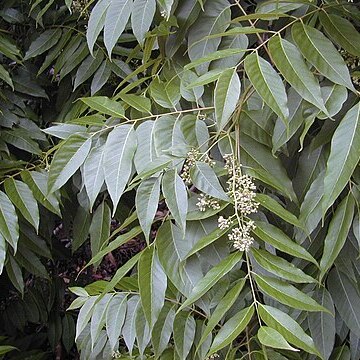Trees to 50 m tall, monoecious, deciduous or semideciduous. Bark grayish brown, fissured, sometimes flaking irregularly; inner bark pink to red; sapwood cream-colored. Leaves spirally arranged, even-pinnate or occasionally odd-pinnate; leaflets usually more than 8 on each side of rachis; leaflet blades glabrous or pubescent with simple trichomes but with club-shaped glands often associated with veins, margin entire, serrate, or dentate; domatia (small deltate axillary pockets) usually present on proximal lateral veins of abaxial surface, often bordered with simple trichomes. Inflorescences much-branched pendent thyrses, often exceeding 1 m. Flowers 5-merous, unisexual with well-developed vestiges of opposite sex present, rarely hermaphrodite, small. Calyx 5(or 6)-lobed or 5(or 6) distinct sepals; sepals imbricate or cup-shaped in bud, margins always ciliate. Petals 5(or 6), white, cream-colored, or pink, distinct, longer than calyx in bud, imbricate (quincuncial), basally adnate to a short pulvinate androgynophore (disk). Stamens 5(or 6), distinct, arising from androgynophore, sometimes alternating with 1-5 filamentous staminodes; anthers in male flowers yellow, dehiscing laterally; antherodes in female flowers often sagittate, brown with abortive pollen. Ovary 5-locular, with 6-10 ovules per locule, vestigial in male flowers; style short in female flowers, pistillodes long and slender in male flowers; stylehead discoid with stigmatic papillae, usually 5-rayed. Fruit a capsule, ellipsoid or obovoid, pendulous, thinly woody, septifragal; valves 5, brown, smooth to verrucose, opening from apex; columella softly woody, concavely or convexly 5-angled, extending to capsule apex. Seeds numerous per locule, winged either at both ends when attached toward distal end of columella or at one end when attached by seed-end to proximal part of columella; wings membranous; endosperm residual; cotyledons collateral, flattened, leaflike; radicle laterally exserted.
Deciduous or semi-evergreen trees. Leaves paripinnate; leaflets entire or toothed. Flowers 5-merous, unisexual (plants monoecious), in large much-branched panicles. Sepals free or partly united. Petals 5, imbricate, adnate at the base by a median carina to the short, cushion-shaped androgynophore. Stamens 5, inserted on the androgynophore; 1–5 thread-like staminodes sometimes present. Ovary 5-locular; locules with 6–10 ovules; style-head discoid with glandular stigmatic papillae. Fruit a pendulous, thinly woody, ellipsoid or obovoid, septifragal capsule, opening from the apex by 5 valves, columella softly woody, 5-angled, extending to the apex of the capsule. Seeds either winged at both ends and attached towards the apex of the columella, or with a single wing and then attached by the seed-end to the base of the columella.
Trees with simple hairs. Leaves usually paripinnate. Inflorescence a thyrse. Flowers unisexual but with vestiges of opposite sex, rarely hermaphrodite. Calyx lobed or of free sepals. Petals 5, free, basally adnate to a short androgynophore (disc which does not surround or obscure the ovary). Stamens 5, free, sometimes with 1–5 staminodes. Ovary 5-locular, each locule with 6–10 ovules; stylehead discoid. Capsule 5-merous, ±woody; columella 5-angled, reaching capsule apex. Seeds numerous, winged at one or both ends.

